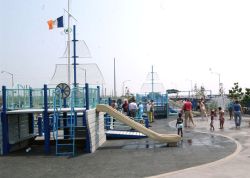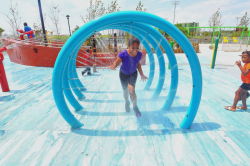Rockaway Beach and Boardwalk
NYC PARKS & UNITED STATES ARMY CORPS OF ENGINEERS ANNOUNCE 12 BLOCKS OF ROCKAWAY BEACH TO REOPEN TODAY AHEAD OF JULY 4 WEEKEND
NYC PARKS & UNITED STATES ARMY CORPS OF ENGINEERS ANNOUNCE 12 BLOCKS OF ROCKAWAY BEACH TO REOPEN TODAY AHEAD OF JULY 4 WEEKENDFriday, July 1, 2022
No. 44
http://www.nyc.gov/parks
Construction complete between Beach 94-106 street
Two blocks of previously closed Beach (94-96) to open; additional swimming access added between 94-106 based on lifeguard availability
NYC Parks and the United States Army Corps of Engineers today announced that construction has been completed between Beach 94-106 street. Twelve blocks of beach that were previously closed to swimming will reopen today, just in time for the July 4 weekend, and six weeks ahead of schedule. Beginning July 1, additional swimming will now be permitted between Beach 94-106 Street when lifeguards are on duty. The U.S. Army Corps’ resiliency work is continuing at Beach 109-117, and will move to Beach 117-121 and Beach 136-140 through September, as previously announced.
Due to the ongoing lifeguard shortage, operations will be adjusted daily based on lifeguard headcounts. Safety remains a top priority and beaches will only open to swimming where we have adequate lifeguard coverage to keep swimmers safe. Beachgoers looking for updated project information and ongoing service changes can visit the NYC Parks dedicated webpage.
“We have remained committed to reopening as much of the beach as quickly as possible, and we are thrilled to be able to open up 12 additional blocks of beach available for full use – six weeks earlier than expected,” said Commissioner Donoghue. “The Army Corps is doing tremendous work for the peninsula and we commend them for their expedient work and great partnership on the project. As always, we urge all New Yorkers; only swim in designated areas during lifeguard hours.”
"The U.S. Army Corps of Engineers, New York District, is pleased to have been able to complete this vital portion of our coastal storm risk reduction project ahead of schedule, which is a substantial benefit to all stakeholders and reaffirms USACE's commitment to getting the job done while continuing to make safety our top priority," said COL Matthew Luzzatto, commander, New York District. "I want to thank all of our partners at the federal, state, and local levels for their tremendous support, as we continue to work tirelessly at our mission to provide additional flood risk reduction measures for the residents of Rockaway."
“Sean Murray, H&L Contracting Superintendent, wants to give a special thank you for the efforts of all his team members including the Local 14, Local 15, Dock Builders, Operating Engineers and Laborers. Their dedication and commitment to focus on the groin at Beach 92nd Street allowed the work to be completed six weeks ahead of schedule.”
Launched in 2020 and scheduled through 2026, the U.S. Army Corps of Engineers’ (USACE) $336 million Atlantic Shorefront Resiliency Project is responsive to decades of calls to address severe erosion and flooding from coastal storms, which has been exacerbated by climate-change, at one of New York City’s most popular beaches. The project consists of 14 new stone groin structures, the rehabilitation of five existing groins, the construction of a reinforced dune system, and sand renourishment on the Atlantic Ocean side of the Rockaway Peninsula. Stone groins are rock structures that extend out into the ocean that will trap sand and reduce beach erosion. They will support sand accumulation, allowing for wider beaches, less erosion, and better protection from storms when complete.
NYC Parks beaches opened for the 2022 season Saturday, May 28, seven days a week, from 10 a.m. to 6 p.m. Beachgoers are directed not to swim in red-flagged areas.
Additional contextual details:
2021
- During summer 2021, B93-103 was closed to swimming due to erosion, but was accessible for other activities. In addition, B142-149 was closed until early July, and 134-143 was closed July-September.
2022
- The full boardwalk IS open.
- Surfing, which is always at your own risk, continueS to be allowed.
- Access to Beach 38-57 remains restricted in accordance with federal guidelines protecting Piping Plovers. Shoreline fencing is currently in place in this section to provide plovers with a space to nest and raise their chicks undisturbed according to the guidelines provided by the U.S. Fish & Wildlife Service.
- NYC Parks Rockaway Beach concessions are open.
- NYC Ferry access to Rockaway Beach is not affected by the resiliency work. Parks will coordinate messaging with NYC Ferry so riders know what to expect when getting off the boat in Rockaway.
ABOUT THE ATLANTIC SHOREFRONT RESILIENCY PROJECT – 10/29/2020
The Rockaway Peninsula was devastated by Hurricane Sandy in 2012. More than 1,000 structures were either substantially damaged or destroyed by the storm surge, which reached a height of 10 feet. Additionally, approximately 1.5 million cubic yards of sand was displaced from Rockaway Beach and deposited on adjacent communities or washed out to sea. Shortly after Sandy, the U.S. Army Corps of Engineers placed approximately 3.5 million cubic yards of sand back onto Rockaway Beach to restore the project to its original design profile and improve resiliency against erosion and coastal flooding. Following Superstorm Sandy, Senators Schumer and Gillibrand secured federal funding for this project as part of the Sandy supplemental appropriations bill (Public Law 113-2). The Senators fought to ensure that the construction of this project would be fully funded by the Federal government.
The Atlantic Shoreline component of this project is a joint effort undertaken by the City of New York, the New York State Department of Environmental Conservation (DEC), and the U.S. Army Corps of Engineers. It is being built at a cost of approximately $336 million in federal funding. This project will be critically important to protecting coastal communities from flooding, severe weather events, and other impacts in the Rockaways caused by climate change.
The first phase of construction includes the construction of 14 new stone groin structures and the rehabilitation of five existing groins on the Atlantic Ocean side of the Rockaway Peninsula. These new stone groins will provide stabilization for a re-nourished sand beach and dune and maintain the protective beach profile.
These improvements will also help restore local ecosystems and ensure the long-term viability of endangered species like the piping plover and sea amaranth. The high winds and fast-moving inundation caused by Hurricane Sandy disrupted the barrier island landscape that provides a home to local flora and fauna.
The second phase of construction will include the construction of a reinforced dune system that will strengthen the shoreline against coastal storms, which are growing more frequent and more destructive due to climate change. The dunes will be constructed with armor stone and steel sheet pile walls at their core, which will reduce wave breaking pressure and limit storm surge inundation and cross-peninsula flooding. All public access points across the dunes will be rebuilt using resilient materials.
The design of this project resulted from extensive analysis to determine best practices for a more resilient beach and shoreline as part of the U.S. Army Corps of Engineers’ East Rockaway Inlet to Rockaway Inlet, and Jamaica Bay Study, which was completed and released in 2018.
The U.S. Army Corps awarded the construction contact to initiate this first major project phase to H&L Contracting LLC of Bay Shore, Suffolk County, for approximately $114 million. Work has begun on the contract with the construction of new groins in the Beach 30s. The full Rockaways – Atlantic Shorefront Project is expected to reach completion within four years.
The Atlantic Shoreline component is the first of two U.S. Army Corps of Engineers major coastal infrastructure projects undertaken to strengthen Rockaway Peninsula. In close coordination with New York City and The New York State DEC, the U.S. Army Corps of Engineers is also advancing the Jamaica Bay component, which will involve constructing a system of berms, floodwalls, and nature-based features along the coastline in flood-prone communities bordering Jamaica Bay. This project is currently in the preliminary design phase and has an estimated cost of $237 million.
Check out your park's Vital Signs
Clean & Safe
Green & Resilient
Empowered & Engaged Users
Share your feedback or learn more about how this park is part of a
Vital Park System










